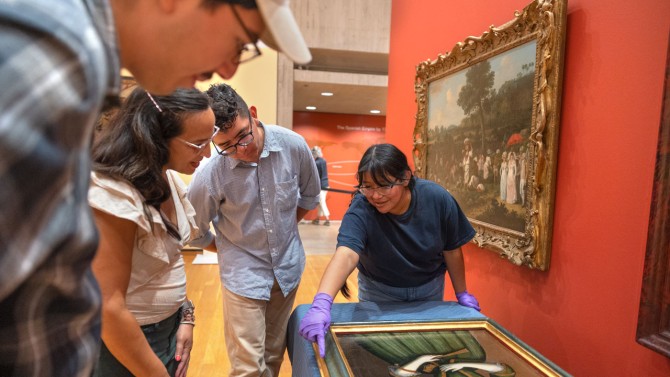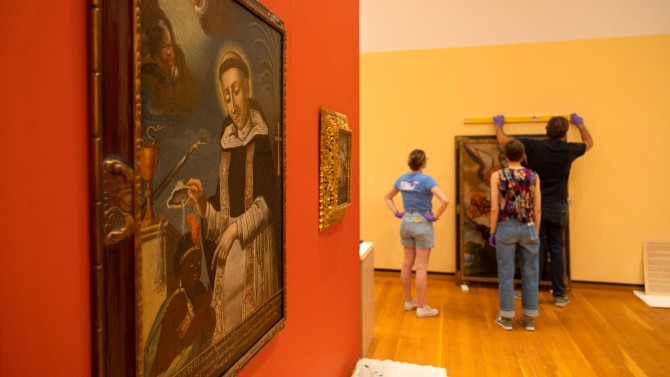A new exhibition at the Herbert F. Johnson Museum of Art is bringing a nuanced view to a complicated and often overlooked period in Latin American art, and it is doing so with a guiding hand and the discerning eye of student curators.
"Colonial Crossings: Art, Identity, and Belief in the Spanish Americas," opening July 20 and on view through December, is the first exhibition of colonial Latin American art at Cornell.
The exhibition features work predominantly created by Indigenous, Black, Asian and mixed-race artists from Mexico, Venezuela, Colombia, Ecuador, Peru, Bolivia, Cuba, Puerto Rico and the Philippines during the period of Spanish colonial rule, which ran from approximately 1492 to 1830.
Ananda Cohen-Aponte, associate professor of history of art and visual studies (center left), discusses a painting with Miguel Barrera '24 (left), Osiel Aldaba '26 and Emily Hernandez '25.
When it comes to showcasing Latin American art, U.S. museums - especially in the Northeast - have generally focused on either pre-Hispanic or modern and contemporary art, leaving the colonial era understudied, according to the exhibition's co-curators, Ananda Cohen-Aponte, associate professor of history of art and visual studies in the College of Arts and Sciences, and Andrew C. Weislogel, the Seymour R. Askin, Jr. '47 Curator of Earlier European and American Art at the Johnson Museum.
Part of the reason for that is colonialism is difficult to discuss.
"In some cases, maybe people have wanted to shy away from a very sticky and complex historical period fraught with contradiction," Cohen-Aponte said. "What we're really trying to do is offer a nuanced understanding, that this is a period of colonial domination, of enslavement, of violence, and also a period of great resilience, ingenuity and creativity."
In preparation for "Colonial Crossings," Cohen-Aponte and Weislogel co-taught a spring seminar, "Colonial Connectivities: Curating the Arts of the Spanish Americas," that provided an overview of colonial Latin American art and the curatorial process to a group of 10 undergraduates and three doctoral students, who took an active role in organizing and shaping the exhibition.
"I feel like the opportunity to be under the hood of putting together an exhibition has been just as rewarding as learning about the artworks I want to show to people," said Miguel Barrera '24, a plant science major in the College of Agriculture and Life Sciences and a Latina/o Studies minor in the College of Arts and Sciences.
The seminar was visited by guest speakers, such as renowned artist Guadalupe Maravilla and Ximena Gómez of the University of Massachusetts, Amherst, and the students took field trips to Cornell University Library's Division of Rare and Manuscript Collections, where they viewed colonial Latin American books and manuscripts, and to Buffalo State University's Garman Art Conservation laboratory.
Johnson Museum staff prepare to hang a painting for "Colonial Crossings: Art, Identity, and Belief in the Spanish Americas," the first exhibition of colonial Latin American art at Cornell, which opens July 20.
The majority of the artworks in the exhibition were selected by Weislogel and Cohen-Aponte and loaned by the Thoma Foundation, the Denver Art Museum and the Hispanic Society of America. Each student chose two artworks in the exhibition to extensively research.
"We saw the students developing a sense of ownership of the material and in some cases, I think, linking personal and family histories to paintings that are hundreds of years old," Weislogel said. "We saw many kinds of 'a-ha' moments. And we learned so much from the students throughout the process. Every class meeting revealed something new."
The students selected two items from the Division of Rare and Manuscript Collections to include in "Colonial Crossings," and they suggested incorporating several pre-Columbian and contemporary pieces from the Johnson Museum's permanent collection, which shows that the exhibition artworks are "are not just pictures that are a part of this irretrievable past, but that they can shed light onto contemporary injustices and legacies that we still live with today," Cohen-Aponte said.
The students also took the lead in designing the exhibition's layout.
"They interacted with each other in such a respectful and generative way," Cohen-Aponte said. "I've been working in this field for a long time, and I would never have thought to put these objects together in these kinds of groupings. It's incredibly unique. I think in this new moment, where especially young people are very much aware of decolonization movements and histories of colonial oppression, our students in particular have allowed us to see these objects in a new light."
Entering the exhibition, visitors encounter a series of Virgin Mary-themed works, followed by pieces that address racial violence and the social fabric of colonial Latin American life. Next are areas dedicated to Asia and the Americas, and placemaking and local knowledge. The exhibition concludes with a look at cultural transformation.
"It's trying to give a full-circle view of what colonial art was, because there's no one thing that defines colonial Latin American art," said Osiel Aldaba '26, who is majoring in architecture in the College of Architecture, Art and Planning (AAP). "There are obviously religious themes, but you also have themes of violence and militancy and agriculture, right? So to try and get the museumgoers to understand the pieces in the same way that we did, I think, was the goal and the way that we laid out the exhibition."
"Colonial Crossings" spans a complicated range of styles and intentions. "Tobias and the Angel," from 1781, reflects the diverse heritage of Puerto Rican painter José Campeche y Jordán, whose African father had been enslaved and whose mother was a Spaniard, whereas "Costumes of the Different Nations of the World," from 1577, is the result of the Eurocentric biases of German printmaker Jost Amman, who relied on written accounts of colonizers and conquistadors when illustrating cultures he never saw himself.
That kind of complexity can be challenging, but it also encourages deep engagement.
"I feel like part of this is the hybridity between the Americas and Europe and creating this new genre and style of art that, to me, feels like the moment of resistance, or a moment of embracing and distinguishing it from Europe," said Emily Hernandez '25, a fine arts major in AAP. "It's not a derivative of Europe. It is its own thing."








